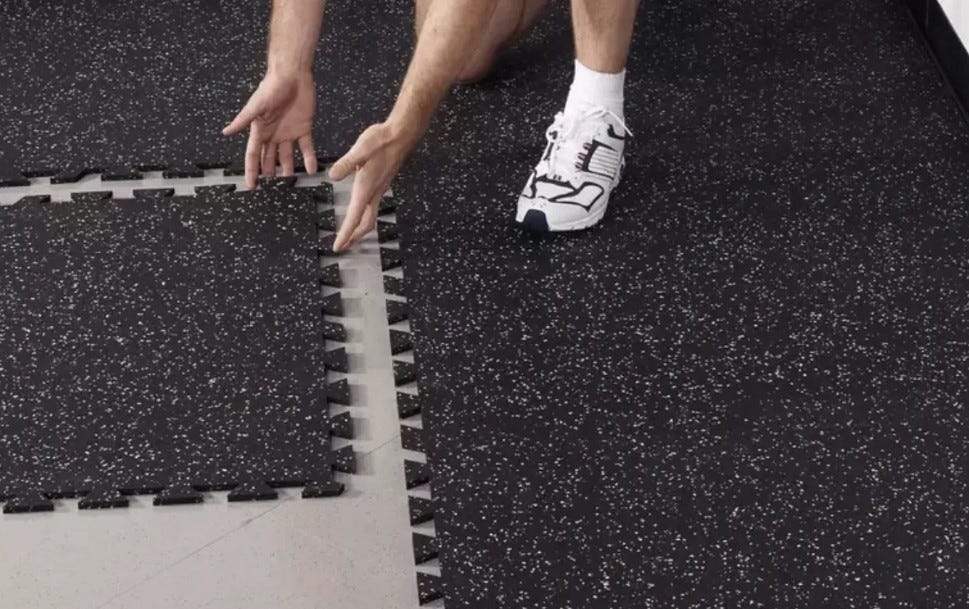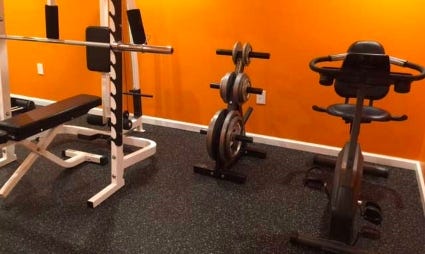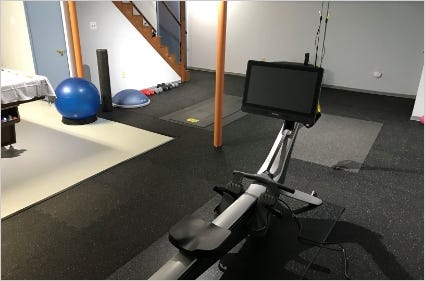
What are Rubber Floor Tiles?
Rubber flooring tiles are the premier home gym flooring option. Known for their ease and accessibility, rubber tiles the perfect DIY gym flooring solution. They fit together like puzzle pieces, offering one of the easiest flooring options on the market.
Rubber tiles are also extremely versatile. While primarily used as gym flooring, rubber tiles are also ideal for playgrounds, outdoors, and other high-traffic areas that require durable and/or waterproof flooring.
Not sure how to choose the right rubber tiles? Keep reading to learn more and shop with confidence.
Customer Favorite Rubber Tile Flooring
Types of Rubber Flooring Tiles
You might think that all rubber tiles are the same, but you actually have a lot of options to choose from! While it’s always great to have more options, it might be hard to know exactly what you need for your space.
Here’s a detailed breakdown of your options to help you decide!
Vulcanized Rubber Tiles
Vulcanized rubber is the cream of the durability crop. During the vulcanization process, the rubber is compressed into dense, ultra-durable, non-porous flooring that’s easy to clean. Vulcanized rubber tiles are perfect for absorbing the shock from even the heaviest weights.
There are two types of vulcanized tiles we carry. If you want maximum durability, look no futher than these.
Non-Vulcanized Rubber Tiles
Non-vulcanized rubber tiles are more common rubber tile type sold today. While non-vulcanized rubber tiles are still incredibly easy to clean and maintain, they are not 100% non-porous the way vulcanized rubber tiles are. Additionally, they are lighter and less dense.
The great news is that non-vulcanized rubber is super affordable. You can find it in just about any thickness or style you want.
Water Jet Cut Rubber Tiles
Rubber tiles can be cut in one of two ways. They can be punched out on a punch press or water jet cut for maximum precision. If you want a rubber tile that is as close to seamless looking as possible, these are great solutions.
High Color Rubber Tiles
Most rubber tiles are made primarily from black recycled rubber tires which makes them super durable and afforadable. Some customers however prefer brightly colored rubber flooring solutions. These are usually made from virgin EPDM rubber and tend to cost a little more. They do tend to stand out though and make the gym feel brighter and more inviting. Here are some of our most popular high color options.
Where to Use Rubber Tile Flooring
Where can you use rubber tiles? As it turns out, almost anywhere, from home gyms to Olympic lifting setups and even commercial gyms. Here are just a few ways you can use rubber tile flooring in your life.
- Home gyms: 1/4" and 8mm thick rubber tiles are perfect for DIY home gyms, and they come in a variety of thickness options to suit your needs. The easy DIY design saves you money on installation.
- Commercial gyms: 8mm, 3/8", and 1/2" thick tiles are versatile enough to handle the huge variety of workouts in a commercial gym. Whether you’re focusing on floor work or cardio, this flooring can handle it.
- Olympic lifting: You can drop heavy weights on these 1/2", 3/4", and 1" thick tiles without worrying about the floor underneath.
How to Install Rubber Floor Tiles
What is the best subfloor for rubber tiles?
Our rubber tiles can go over any hard, flat surface. Rubber tiles do best over concrete, plywood, hardwood, ceramic or porcelain tiles, or even on top of compacted dirt. Any subfloor must be leveled to ensure safety and a flat surface for workouts.
You can even install rubber flooring over carpet, as long as it is short, low-pile carpet. If you have plush carpet that you can’t remove, you can lay plywood over the plush carpet and install your rubber tiles over the plywood, or choose rubber flooring designed for plush carpet, like 1" Monster Rubber Tiles.
How to Clean Rubber Tile Flooring
Rubber Tiles are extremely easy to maintain and keep clean. Maintenance for interlocking rubber tiles includes:
- Sweep or vacuum: Remove any loose crumbs, dust, or debris. Use a broom or a vacuum without a beater brush to avoid scratching the rubber floor. If you have no alternative, a soft beater brush is best.
- Mop: Occasionally damp mop with a mild soap and water solution or a Rubber Floor Cleaner and Degreaser. Use a mop with a sponge or synthetic mop head, and avoid cotton mops
Note: Do not use any solvent or oil style cleaners such as Pine Sol, Lysol, Murphy’s Oil Soap, WD40, paint thinner, etc. since these types of cleaners will break down the flooring over time.
Other Helpful Rubber Tile Content


Do you need more information to help decide which rubber tile might be best for you? This guide is a great resource for you. Topics include the pros and cons to using rubber tiles, how they are shipped, FAQ's, and many more.


Best Home Gym Flooring Options
Are you aiming to build out a home gym to achieve your fitness goals? This helpful guide will walk you through all the best flooring options. Learn about the advantages to using rubber tiles versus rubber rolls, foam vs. carpet vs. rubber, and more
Rubber Tiles vs. Rolls: Which One's Best for You?
Are you still undecided between rubber floor tiles and rubber rolls? This helpful guide breaks down the key differences of each.
Rubber Floor Tile Reviews
“The flooring went down without issue. I love it! It was the best choice I could have made. It looks great with the vibrant orange walls. Fantastic quality.
No issue with all the heavy equipment lying on top of the floor. Can't tell you how pleased we are. I wouldn't hesitate to purchase from this company.”
- Patrick C. from Asbury Park, NJ
“Two seniors 66yr (husband & wife) cleaned out the basement to build a home gym. We installed 330 sqft. (90 tiles) of 6mm rubber flooring and 12’ of floor ramp in a couple of days.
Installation was very smooth and cutting the rubber tiles with a sharp knife was easy. I used a saw to cut the ramps to fit the outer edges. I attached some before and after photos. We love our new floor.”
- Joanne and Bob B. from Marshfield, MA











